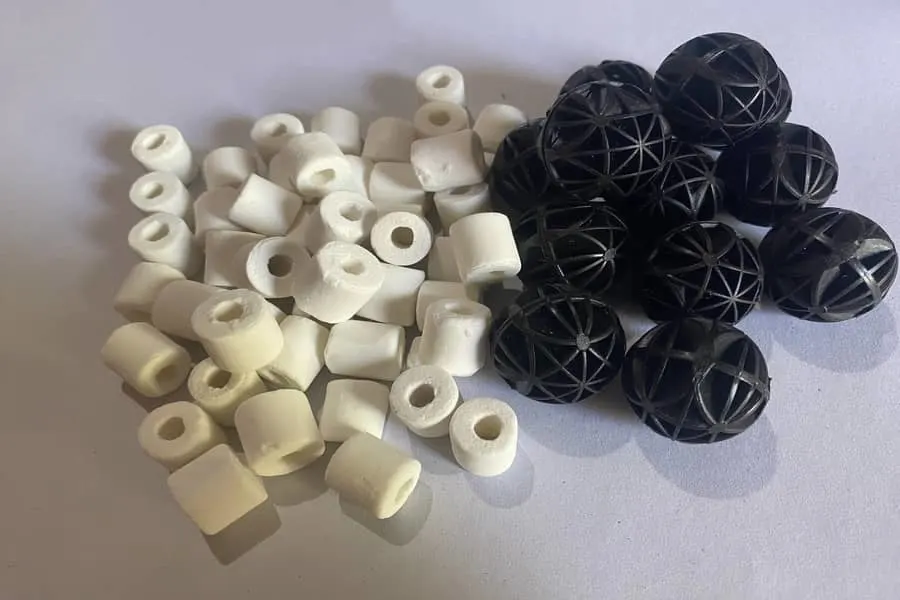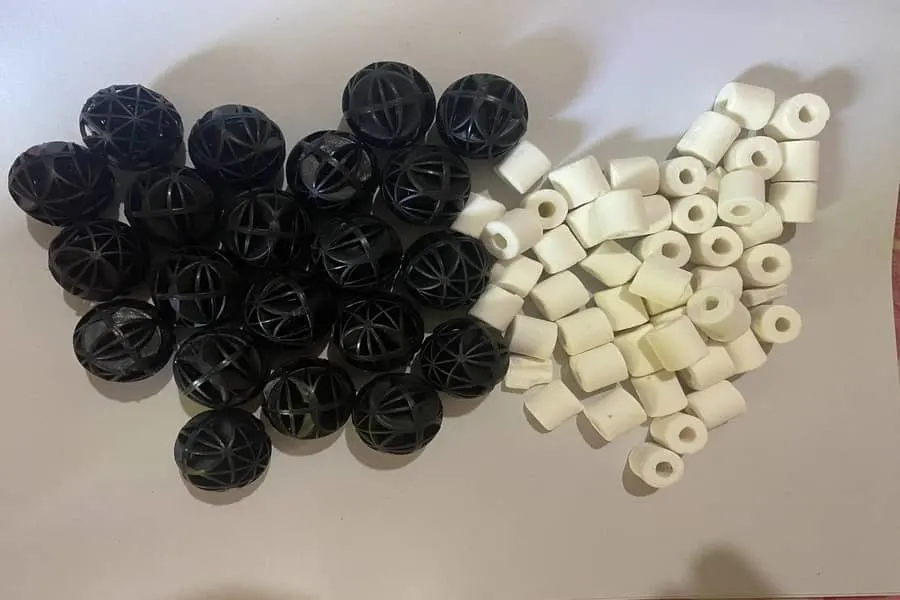This post may contain affiliate links.

Many hobbyists often find themselves confused between ceramic rings and bio balls. How do you decide which one is better for your aquarium? Some say ceramic media has more benefits than plastic bio balls. But how valid is this claim? Let’s find out!
Ceramic rings host more beneficial bacteria than bio balls and can also provide denitrification. However, the porous ceramic material is susceptible to clogging and doesn’t last long compared to bio balls. Ceramic rings work best in canister filters and HOBs. Bio bolls are efficient when used in wet/dry or trickle filters.
To keep our biases aside, we scoured the internet to gather expert opinions and lurked around public forums to see what experienced aquarists had to say about the topic. The following article is a detailed comparison of ceramic rings and bio balls.
What’s Better: Bio Balls or Ceramic Rings
We have breakdown the whole comparison based on various factors to make it easy to understand.
Provides Denitrification
Both ceramic rings and bio balls can hold beneficial nitrifying bacteria, which helps break down the harmful ammonia into nitrites and then into less toxic nitrates.
Due to internal surface area, ceramic rings go a step further and provide denitrification or the removal of nitrates from the aquarium. Whereas the surface area of bio balls is all external and exposed to oxygen-rich water, thus no denitrification.
The risk of bio balls turning into a ‘nitrate factory’ concerns most aquarists. However, it can be prevented with proper maintenance, cleaning detritus, and build-up in the sump.
Nitrates are not toxic for most freshwater fish unless it is available in higher concentrations. The best way to get rid of excess nitrates is to perform frequent water changes.
More Surface Area
Ceramic rings, being extremely porous, offer more surface area than bio balls. The largest surface area will host the most bacteria.
So it’s a no-brainer that ceramic media wins here.
Prone to Clogging
The upside of ceramic rings is, unfortunately, the downside too. The tiny pores that offer a lot of surface area to beneficial bacteria also make the media susceptible to clogging.
Even though the bio media always goes after mechanical filtration, the micropores of ceramic rings are difficult to prevent from getting in contact with small debris particles.
Regularly cleaning ceramic rings helps increase their lifespan. However, as the media continue to come into usage, little by little, the pores on the surface may get permanently blocked.
This will cause the surface area to decrease, resulting in reduced effectiveness. And eventually, you will need to replace your ceramic rings.
On the other hand, bio balls have large openings that don’t clog easily as some other media. Anything that may potentially clog bio balls will already be filtered out as the aquarium water passes through the prefilter.
To ensure your bio media stay clean and remain usable for many years, one must have a robust mechanical filtration and maintenance routine in place.
Long Lasting
You don’t need to replace bio balls as long as they don’t wear out. When they start to get dirty, clean them, and they will work for a lifetime.
Ceramic rings, if kept clean and taken good care of, will last for years. Depending on the usage and maintenance, you can expect them to have 5-6 years of useful life.
Most aquarists suggest not throwing out bio media. Just swirl it around in tank water every few months to get the gunk off the surface. You will only need to replace the media, be it ceramic rings or plastic bio-balls, when they start to crack or fall apart.
Should You Use Ceramic Rings or Bio Balls?

The answer isn’t always black and white.
Apart from knowing which media is better than another (in certain areas), one must also know the settings in which these bio media are best-suitable.
Bio balls are best for an open-air environment
Bio balls are most effective in filters with direct access to open air (wet-dry filters, trickle filters) as opposed to a closed system (canisters.)
Bio balls aren’t meant to stay submerged. They are designed to have water gently trickle over them, so the media remains wet and also allow air to oxygenate the nitrifying bacteria.
Bio balls are best suited for wet/dry applications and require more size & space to function efficiently. They are mainly used as a water stream breaker to enable the water to go into the bio-media evenly and with higher oxygen exchange.
Use ceramic rings in sealed systems
Porous ceramic rings are most suitable for sealed systems like canister filters or HOB. They are small in size, requiring less space but delivering a maximum surface area for bacterial growth.
Ceramic rings require to be completely submerged underwater at all times for the bacteria to survive and thrive.
Bio media of any type is best placed when it goes after mechanical media and before chemical media. However, if your filter doesn’t provide enough space to accommodate ceramic rings, you can simply bag them and put it directly into the tank on the gravel bed where there is sufficient water flow.
Related Questions
How many ceramic rings do you need per gallon?
There is no definite number for how many ceramic rings you need for your aquarium. Be it ceramic rings or any other form of bio media, as they don’t cause harm to your fish, feel free to use as many as you can fit in your filter.
Can you use bio balls and ceramic rings together?
Bio balls and ceramic rings can be used together in your fish tank. However, keep in mind that ceramic media is required to be submerged, and bio balls do not.
What are the best brands to buy bio balls and ceramic rings from?
Marineland, Biohome, Seachem Matrix, Eheim, and Fluval are some of the best and most reliable manufacturers of biological filter media.
How to prevent tiny pores of ceramic rings from getting clogged?
Use multiple layer prefilter of different densities to ensure even the tiny detritus particles are caught before the water passes through the bio media. On top of it, perform regular cleaning of your rings, so they don’t accumulate gunk and remain usable for many years.
Can you use bio balls in a canister filter?
Bio balls aren’t meant for closed systems like canisters and won’t work as well as other dense media. Bio balls provide a lot of air space, as they are made to have water trickle through them while being exposed to oxygen.
In a canister, the media has to be submerged, which is clearly not what bio balls are designed for.
Final Words
You must choose between ceramic rings and bio balls based on your specific requirements.
Suppose you need a media with the largest surface area; go with ceramic rings. However, remember that you’ll be challenged to keep the porous ceramic material free from gunk. It will require efficient mechanical filtration and routine maintenance.
Another best way to choose a bio media is based on the type of filter. Ceramic rings are suitable for closed systems such as canister filters and HOB. Whereas, bio balls work efficiently when used in wet-dry or trickle filters.
